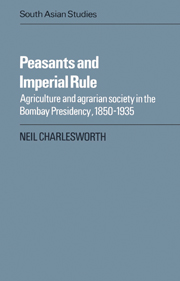Book contents
- Frontmatter
- Contents
- List of maps and tables
- Preface
- Note on technical terms and references
- Maps
- 1 Introduction: the peasant in India and Bombay Presidency
- 2 The village in 1850: land tenure, social structure and revenue policy
- 3 The village in 1850: land and agriculture
- 4 Indebtedness and the Deccan Riots of 1875
- 5 Continuity and change in the rural economy, 1850–1900
- 6 The Bombay peasantry, 1850–1900: social stability or social stratification?
- 7 The agricultural economy, 1900–1935: the critical watershed?
- 8 The impact of government policy, 1880–1935
- 9 The peasant and politics in the early twentieth century
- 10 Conclusions: the problem of differential commercialisation
- Glossary
- Bibliography
- Index
- Frontmatter
- Contents
- List of maps and tables
- Preface
- Note on technical terms and references
- Maps
- 1 Introduction: the peasant in India and Bombay Presidency
- 2 The village in 1850: land tenure, social structure and revenue policy
- 3 The village in 1850: land and agriculture
- 4 Indebtedness and the Deccan Riots of 1875
- 5 Continuity and change in the rural economy, 1850–1900
- 6 The Bombay peasantry, 1850–1900: social stability or social stratification?
- 7 The agricultural economy, 1900–1935: the critical watershed?
- 8 The impact of government policy, 1880–1935
- 9 The peasant and politics in the early twentieth century
- 10 Conclusions: the problem of differential commercialisation
- Glossary
- Bibliography
- Index
Summary
This book has been a long time in the making. My work on the subject of the Bombay peasantry in the British period began when I was a research student at Cambridge in the early 1970s and has continued since then during my time at Glasgow. Over this period I have incurred many debts. Financially, I have been assisted by the Social Science Research Council, which sponsored my original research, Cambridge University, through the award of the Holland Rose Studentship, and Glasgow University, with a number of additional grants. I am grateful to librarians and archivists, in particular in four institutions: the Maharashtra State Archives in Bombay, the India Office Library and Records and the University Libraries of Cambridge and Glasgow.
Academically, I have benefited enormously from the fertile climate of debate in South Asian history which existed at Cambridge while I was there and also, since, from numerous valuable discussions with colleagues and friends at Glasgow. It would be invidious to name names but many may notice here the influence of their ideas and I am grateful to them. One academic debt is, however, so fundamental that it must be specifically recorded. The late Professor Eric Stokes first suggested the subject as an area of research to me in 1969 and thereafter as supervisor and friend constantly supported the work's development until his untimely death in February 1981. It is a source of deep regret to me that this book was not published during his lifetime. At least, I can record here the very great debt which I owe to him and to the example of scholarship and academic comradeship which he set.
- Type
- Chapter
- Information
- Peasants and Imperial RuleAgriculture and Agrarian Society in the Bombay Presidency 1850–1935, pp. xPublisher: Cambridge University PressPrint publication year: 1985

